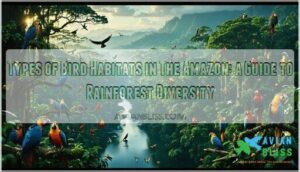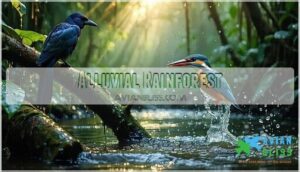This site is supported by our readers. We may earn a commission, at no cost to you, if you purchase through links.

You’ll find the emergent layer, towering above the canopy, where giant eagles and macaws thrive.
The canopy layer, dense with fruit, is perfect for parrots and toucans.
Below that, the understory supports insect-loving birds like antbirds and hummingbirds, while the forest floor hosts shy foragers such as antpittas.
Don’t forget riverine and swampy areas, where water-loving species stick close to the shores, or the Cecropia-filled understory, a haven for smaller species.
Each habitat offers unique conditions, shaping the incredible variety of birds in this vibrant rainforest!
Table Of Contents
- Key Takeaways
- Amazon Bird Habitats
- Types of Rainforests
- Bird Habitat Characteristics
- Environmental Factors
- Conservation Efforts
- Frequently Asked Questions (FAQs)
- What are the different habitats in the Amazon rainforest?
- Where do Amazon birds live?
- What are the different types of rainforest habitats?
- What habitat has the most birds?
- What birds live in the Amazon Rainforest?
- What are the different habitats in the Amazon Rainforest?
- What are the common habitats for birds?
- How do seasonal floods impact Amazonian bird habitats?
- What role do river islands play for birds?
- How do birds adapt to bamboo-dominated forests?
- Conclusion
Key Takeaways
- You’ll find unique bird habitats in the Amazon’s emergent layer, canopy, understory, and forest floor, each supporting specific species with specialized needs.
- Birds thrive in riverine areas and swampy regions, adapting to seasonal floods and dynamic environments packed with food and nesting sites.
- Vegetation density, canopy cover, and soil composition are key factors shaping bird habitats and their ability to flourish in different layers of the rainforest.
- Preserving bird habitats helps maintain biodiversity, counteracts threats like deforestation, and ensures the survival of countless Amazon species.
Amazon Bird Habitats
You’ll find that the Amazon’s bird habitats are as varied as the rainforest itself, ranging from dense canopies to flooded riversides and understory thickets.
These ecosystems provide food, shelter, and nesting spots, supporting thousands of species with unique adaptations, including varied habitats that are essential for their survival.
Tropical Rainforest Habitats
Tropical rainforest habitats in the Amazon are like bustling apartments, with forest layers creating homes for canopy birds and understory birds alike.
Layers of the Amazon rainforest hum with life, offering vibrant sanctuaries for canopy dwellers and shy understory birds alike.
The rich canopy structure hosts countless avian niches, while microclimates shaped by dense vegetation provide perfect conditions for diverse species.
Habitat fragmentation threatens these intricate ecosystems, but preserving these bird habitats guarantees the Amazon rainforest’s vibrant life thrives uninterrupted, thanks to the preservation of their natural microclimates.
Riverine and Swampy Areas
In the Amazon basin, riverine birds thrive along waterways, showcasing unique waterway foraging skills.
Riverine birds master the art of foraging along Amazon waterways, thriving amidst lush, dynamic ecosystems shaped by flowing rivers.
Swamp adaptations help species like waders navigate flooded seasons, where floodplain species nest and forage.
Island habitats along river bends offer shelter for Amazon rainforest birds, while sandbars teem with wildlife.
These bird habitats highlight the rich diversity of tropical rainforest life, shaped by ever-changing water levels.
Cecropia Dominated Understory
If you’ve ever wondered how birds adapt to recovering forests, the Cecropia-dominated understory is a prime example.
These quicker-growing trees create bird-friendly habitats rich in light and food.
Here’s what makes it special:
- High bird diversity, with 87 species observed.
- Successional stages mimicking primary forests.
- Understory dynamics fostering avian adaptations.
- Amazon rainforest birds benefiting from regenerating habitat types.
Types of Rainforests
You’ll find that not all rainforests in the Amazon are the same, as they vary widely in structure, vegetation, and soil composition.
From open forests with scattered trees to dense, shadowy canopies, each type creates unique habitats supporting different bird species.
Open Rainforest
Step into the open rainforest, where sunlight penetrates through an open canopy, creating warm pockets perfect for bird species like macaws and toucans. This habitat type, shaped by edge effects, encourages bird dispersal and species adaptation.
A mix of dense foliage and clearings fosters avian diversity, making it an ecological hotspot in the Amazon Rainforest. Deforestation’s impact, however, can lead to habitat fragmentation issues.
| Feature | Description | Importance |
|---|---|---|
| Canopy Openness | Sparse tree cover | Promotes sunlight penetration |
| Light Levels | High | Essential for plant growth |
| Habitat Types | Pockets of dense and open areas | Supports diverse species |
| Bird Species | Macaws, toucans, and tanagers | Enhance avian diversity |
| Ecological Effects | Interplay of light and moisture | Drives rainforest ecology |
Dense Rainforest
Beneath towering trees, the dense rainforest is a world of canopy density, vibrant understory birds, and hidden nesting sites.
Its lush vegetation and shaded forest floor create perfect conditions for insect abundance, supporting diverse bird species in the Amazon.
- Provides vital shelter for understory birds.
- Offers rich insect abundance for feeding.
- Hides nesting sites among layers of thick vegetation.
Alluvial Rainforest
Alluvial rainforests, shaped by erosion and shifting rivers, boast nutrient-rich soils essential for bird habitats.
Flooding impacts species distribution, creating blackwater and whitewater flooded forests that nurture tropical birds.
Here, adaptations like unique diets and nesting in taller trees emerge, sustaining Amazon rainforest diversity, listed among key homes for species like the Bare-necked Fruitcrow and Amazon Kingfisher.
High Terraces of Open Floodplain Forest
High terraces of open floodplain forest in the Amazon rainforest offer unique bird habitats shaped by floodplain ecology and seasonal flooding.
These terraces support terrace birdlife with distinct avian adaptations, including species that thrive in:
- Open canopies dominated by bitternut hickory.
- Sandy loam soils from alluvial deposits.
- Elevated terrains above normal flood stages.
- Fluctuating water levels influencing forest succession.
Bird species flourish here amid tropical rainforest diversity.
Bird Habitat Characteristics
When you explore bird habitats in the Amazon, you’ll notice how factors like soil, canopy cover, temperature, and vegetation shape each ecosystem.
These characteristics aren’t just details—they’re critical to understanding why certain birds thrive in specific areas, which is a key aspect of understanding ecosystem dynamics.
Soil Composition
The soil in the Amazon rainforest plays a pivotal role in tropical rainforest ecology, supporting forest floor birds.
These soils are acidic, nutrient-poor, and heavily weathered, yet nutrient recycling keeps the ecosystem thriving.
| Factor | Description |
|---|---|
| Soil Nutrients | Limited, locked in decaying leaves. |
| Acidity Levels | High, challenging plant growth. |
| Mineral Content | Low, varying by location. |
Soil influences water retention and erosion impact, which are crucial factors in the Amazon rainforest ecosystem, making nutrient recycling essential for its survival.
Canopy Cover
Understanding canopy cover is essential in tropical rainforests, as it affects light penetration and species distribution.
Canopy height shapes forest structure, influencing bird abundance and habitat quality. Birds thrive in diverse layers, from dense cover to fragmented patches, depending on ecosystem health.
A rich canopy creates varied forest habitats, supporting an array of bird species critical to the rainforest’s balance. This diversity is key to maintaining a healthy ecosystem where birds can flourish in diverse layers.
Temperature and Humidity
Temperature and humidity shape survival in the Amazon’s forest habitats.
Birds adapt cleverly to this tropical ecosystem’s steamy environment.
- Thermal regulation means feathers aren’t just for flying—they’re a personal thermostat.
- Humidity impacts nesting in dense foliage.
- Microclimate variation creates cozy hideouts for shy species.
- Evaporation rates affect splashy bathing birds.
- Species distribution thrives amid steamy layers of tropical ecosystems.
Toucans, for example, display vibrant plumage suited for rainforest life.
Vegetation Structure
Vegetation structure shapes rainforest habitats, creating space for understory birds and diverse species.
With dense plant layers and towering tree heights, every corner supports life.
Epiphyte abundance and understory composition offer shelter and food.
Compare primary and secondary forests or explore fragments that foster unique bird behaviors.
| Factor | Primary Forest | Secondary Forest | Forest Fragments |
|---|---|---|---|
| Forest Layers | Complex | Simplified | Variable |
| Plant Density | High | Moderate | Low |
| Tree Height | Towering | Mid-level | Limited |
| Understory Birds | High diversity | Adaptable | Reduced presence |
The table summarizes the differences between primary forest, secondary forest, and forest fragments, highlighting variations in forest layers, plant density, and tree height.
This information is crucial for understanding the diverse species and their habitats.
Environmental Factors
You’ll find that a bird’s habitat in the Amazon isn’t just about where it lives but how environmental factors shape its daily survival.
Temperature, humidity, and canopy cover all play essential roles, creating unique challenges and opportunities for these feathered residents, where environmental factors shape their daily survival.
Influence of Temperature
In Amazon bird habitats, heat plays a leading role in bird habitat preferences and species distribution.
Birds adapt with thermal regulation techniques, like seeking shaded tropical bird habitats.
Here are five ways temperature influences them:
- Dictates breeding seasons.
- Prompts altitudinal migration during heatwaves.
- Drives bird habitat selection.
- Influences foraging patterns.
- Exacerbates climate change challenges.
Influence of Humidity
Humidity gradients in the Amazon create specialized microclimates.
High humidity boosts insect abundance, benefiting insectivorous birds.
Yet, mold growth from damp conditions challenges bird physiology, affecting nesting.
Habitat quality assessment depends on understanding these moisture patterns.
Birds thrive in tropical forest bird habitats that minimize extremes.
Habitat use patterns reflect their clever adaptation to humidity’s quirks—especially when it’s like nature’s version of a sauna!
| Humidity Levels | Effect on Birds | Impacts on Habitat |
|---|---|---|
| Low Humidity | Stress on bird physiology | Reduced insect abundance |
| Ideal Humidity | Healthy bird adaptation | Balanced microclimates |
| High Humidity | Encourages mold growth | Challenges nesting |
| Fluctuating Gradients | Dynamic habitat use patterns | Promotes resource diversity |
Influence of Canopy Cover
A rainforest’s canopy density shapes light penetration, directly impacting Amazon bird species.
Thick canopies support shade-loving bird communities, while open gaps create zones of abundant food availability.
Canopy cover also determines nesting sites and influences habitat use.
In forest fragments, reduced cover affects bird abundance, making tropical forests essential for maintaining balance in bird populations and fostering diverse ecosystems. Preserving these areas is key, as habitat loss degrades ecosystems.
Interaction Between Environmental Variables
Environmental variables don’t act alone—they’re like a rainforest symphony, each part influencing the others.
Temperature, humidity, and canopy cover shape Amazon bird species’ habitats and behaviors. Changes in one ripple across the ecosystem, impacting species distribution and resource availability.
- Climate change magnifies habitat fragmentation, altering forest fragments.
- Resource shifts reshape Amazon forest ecology.
- Ecosystem dynamics influence bird habitat use, which is part of the larger ecosystem dynamics.
Conservation Efforts
You’ve got a vital role in protecting Amazon bird habitats, which face serious threats like deforestation and habitat destruction.
By supporting sustainable practices and local conservation efforts, you help preserve the rainforest’s incredible biodiversity for future generations.
Threats to Bird Habitats
Without healthy habitats, birds in the Amazon face alarming threats.
Habitat loss from deforestation, climate change, and human encroachment fragments their homes, while pollution effects and habitat degradation wreak havoc on ecosystems.
Forest fragments struggle to support wildlife, leaving bird populations vulnerable.
To support these efforts, consider Amazon bird conservation efforts.
Let’s break it down:
| Threat | Impact on Birds |
|---|---|
| Habitat Loss | Reduced nesting areas |
| Deforestation Impact | Diminished food availability |
| Climate Change | Shifting bird migration patterns |
| Pollution Effects | Contaminated water and soil |
| Habitat Fragmentation | Smaller, isolated populations |
The key issue is the combination of these threats, including habitat loss, deforestation, and climate change, which all contribute to the decline of bird populations.
It is essential to address these problems to protect the Amazon’s biodiversity.
Sustainable Practices
Sustainable practices are key to preserving Amazon bird habitats while enjoying their beauty.
Mindful eco-tourism and ethical birding can guarantee minimal impact. Here’s how you can contribute:
- Support habitat restoration projects improving ecosystems.
- Choose sustainable tourism options prioritizing environmental protection.
- Practice ethical birding by avoiding disturbance.
- Engage in activities promoting carbon offsetting to reduce your environmental footprint.
To further minimize disturbance, consider respecting bird distance.
Support for Local Conservation Efforts
Engaging with local conservation efforts helps protect Amazon wildlife and its incredible birdlife.
Community involvement boosts education programs and policy advocacy, while ecotourism benefits funding allocation.
Supporting initiatives strengthens ecosystem protection and enriches biodiversity.
You can also contribute through rainforest conservation donations to further these efforts.
| Effort | Impact | Example | Outcome |
|---|---|---|---|
| Community Involvement | Informs locals | Village workshops | Better bird conservation |
| Ecotourism Benefits | Funds protection | Guided wildlife tours | Sustainable ecosystems |
| Education Programs | Raises awareness | School visits | Youth enthusiasm for biodiversity |
| Policy Advocacy | Supports laws | Endorse stricter deforestation rules | Stronger environmental protection |
Importance of Preserving Biodiversity
Biodiversity keeps ecosystems stable, connecting bird species and other Amazon wildlife through a complex web of species interdependence.
Preserving Amazon habitats isn’t just an ethical imperative—it safeguards genetic diversity and boosts conservation benefits for all life.
Here’s why it matters:
- Supports bird species survival.
- Maintains species diversity.
- Protects future resources.
- Guarantees habitat conservation.
- Promotes Amazon wildlife health.
Supporting bird habitat conservation can greatly improve these efforts to preserve Amazon habitats and ensure species diversity, which is crucial for conservation benefits and overall wildlife health.
Frequently Asked Questions (FAQs)
What are the different habitats in the Amazon rainforest?
In the Amazon, you’ll find diverse habitats like dense lowland forests, mountainous regions with cool air, riverine areas teeming with life, and secondary forests recovering from disturbance.
All these habitats house birds adapted to specific niches.
Where do Amazon birds live?
With over 1,500 bird species, the Amazon’s feathered residents thrive in diverse habitats like riverbanks, dense lowland forests, mountainous regions, and even waterways.
Each layer of the rainforest offers birds unique spaces to nest, hunt, and sing, making it an ideal environment for them to thrive.
What are the different types of rainforest habitats?
Rainforest habitats include dense lowlands rich in fruits, elevated mountains with cooler air, riverbanks teeming with life, and lush forest canopies.
Each layer provides food, shelter, and unique microclimates for incredible biodiversity to thrive.
What habitat has the most birds?
You’ll find the most bird species in lowland habitats near rivers and streams.
These areas are rich in food, like fruits and insects, and dense vegetation offers perfect nesting spots, making them a bird paradise.
What birds live in the Amazon Rainforest?
Picture a Harpy Eagle gracefully hunting monkeys and sloths.
The Amazon Rainforest is home to vibrant macaws, playful toucans, elusive Sunbitterns, and the ancient Hoatzin, showcasing breathtaking biodiversity at every turn.
What are the different habitats in the Amazon Rainforest?
You’ve got a variety of habitats in the Amazon, from towering canopy layers teeming with life to shaded understory areas.
Vibrant riverbanks, swampy wetlands, and even mountainous regions offering cooler, diverse niches for unique species.
What are the common habitats for birds?
Birds thrive in diverse Amazon habitats, including towering canopies, dense understories, riverbanks, and mountain slopes.
Each habitat offers unique shelter, food, and nesting opportunities, supporting species like macaws, toucans, and eagles adapted to specific ecosystems.
How do seasonal floods impact Amazonian bird habitats?
Seasonal floods in the Amazon can transform bird habitats dramatically.
Floodwaters create unique feeding opportunities, like floating vegetation for fish-eating birds, but they also displace nesting sites, forcing birds to adapt to higher ground or tree canopies.
What role do river islands play for birds?
Think of river islands as nature’s bird nurseries, offering safe havens with abundant food like insects and fruits.
They provide critical nesting spots, especially during floods, helping birds thrive in the Amazon’s dynamic, watery landscape.
How do birds adapt to bamboo-dominated forests?
In bamboo-dominated forests, birds adapt by utilizing the dense vegetation for nesting and camouflage.
They also feed on abundant insects, and evolve slender beaks or strong legs to navigate and forage effectively through tight bamboo clusters, which allows them to thrive in these unique environments by utilizing the dense vegetation.
Conclusion
Exploring the types of bird habitats in the Amazon reveals how this rainforest buzzes with life at every level.
From the emergent layer’s towering heights to riverine edges teeming with water-loving species, each habitat offers unique surprises.
You’ll marvel at how soil, canopy cover, and humidity shape these ecosystems, supporting extraordinary bird diversity.
By protecting these environments, you’re saving bird habitats as well as preserving Amazon’s vibrant heartbeat.
So, let’s nurture this natural masterpiece together!














